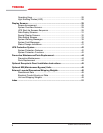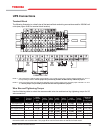
7
1600EP Series Instruction Manual
Installation Precautions
CAUTION
Install the unit in a well-ventilated location; allow at least 4 inches (10 cm) on all sides for air
ventilation and for maintenance.
Install the unit in a stable, level and upright position that is free of excessive vibration.
Install the unit where the ambient temperature is within the range specied on pages 16 and 19.
DO NOT install the UPS in areas that are subject to high humidity.
DO NOT install the UPS in areas that allow exposure to direct sunlight.
DO NOT install the UPS in areas that allow exposure to high levels of airborne dust, metal particles,
or ammable gases.
DO NOT install the UPS in areas near sources of electrical noise. Ensuring a proper earth ground
will reduce the effects of electrical noise and will reduce the potential for electrical shock.
DO NOT install the UPS in areas that would allow uids or any foreign object to get inside the
UPS.
The UPS generates and can radiate radio-frequency energy during operation. Although RFI noise
lters are installed inside of the unit, there is no guarantee that the UPS will not inuence some
sensitive devices that are operating near by. If such interference is experienced, the UPS should
be installed farther away from the affected equipment and/or powered from a different source than
that of the affected equipment.
The user should provide output over-current protection for hardwired UPS systems. See the
section titled Specications on page 15 and 18 for the device rating.
After ensuring that all power sources are turned off and isolated in accordance with established
lockout/tagout procedures, connect the power source wiring of the correct voltage to the input
terminals of the UPS.
Connect the output terminals of the UPS to the load (refer to NEC Article 300 – Wiring Methods and
Article 310 – Conductors For General Wiring). Size the branch circuit conductors in accordance
with NEC Table 310.16.
Conductor Routing and Grounding
Use separate metal conduits for routing the input power, output power, and control circuits.
Follow the wire size and tightening torque specications listed on page 11.
Always ground the unit to reduce the potential for electrical shock and to help reduce electrical
noise.
A separate ground cable should be run inside the conduit with the input power, output power, and
control circuits.
WARNING
THE METAL OF CONDUIT IS NOT AN ACCEPTABLE GROUND.
1.
2.
3.
4.
5.
6.
7.
8.
9.
10.
11.
12.
1.
2.
3.
4.


















